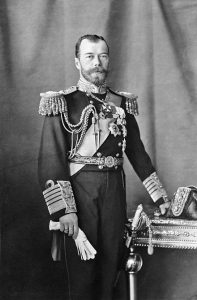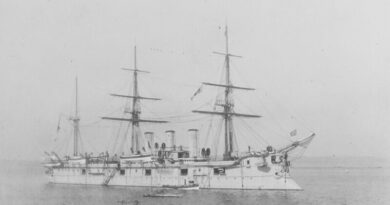The Russian Tsars

Artist: Viktor M. Vasnetsov (1848–1926)
Title: Tsar Ivan The Terrible
Date: 1897
Medium: oil on canvas
Dimensions: 247 x 132 cm
Current location: Tretyakov Gallery, Moscow
IVAN THE TERRIBLE was one of the most significant and controversial figures in Russian history, Ivan IV, or Ivan the Terrible as he is more commonly known, changed the face of Eastern Europe forever. In power for over 50 years, Ivan left behind a complicated legacy; on one hand as an unparalleled military leader and on the other, the military successes the achieved were marred by mental instability.
Ivan IV was responsible for turning Russia from a Medieval state into a vast empire and world power spanning over a million square miles and all the while his mental state grew increasingly volatile throughout his life as he carried out the ruthless oppression of his people. Amongst Ivan’s most significant contributions to history was his creation of the Tsardom, the autocratic and centralised form of rule, which would dominate the Russian Empire for centuries to come. Prior to his accession to the throne, the title of Russia’s ruler was the Grand Prince. Ivan however, changed everything. Proclaiming himself the Tsar of all the Russia’s, he added a religious dimension to his power. Not only was he his subjects’ political leader but also their religious leader, answering only to God. This new religious component to Ivan’s power enabled him a sense of authority afford to none of his predecessors, surrounding him with an aura of invincibility, ensuring that any threats to his power could remain suppressed.
As successful as this element of his rule was, it was however, not the only way Ivan kept his subjects in check. Ivan earned his terrifying reputation through relentless oppression he inflicted upon his people, particularly the Boyar Elite-the noble families, whom he perceived as a threat to his power. In the 1560’s, Ivan established the Oprichnina, essentially a state within a state, which was the head quarters to the brutal secret police known as the Oprichniki who carried out several arrests and executions of those Ivan believed to be conspiring against him. As Ivan’s mental state deteriorated, these acts of barbarism became increasingly common. His oppression reached a crescendo with the Massacre of Novgorod in 1570, a brutal purge, with 60,000 people murdered under Ivan’s command another major factor in the city’s decline from its position of prominence. Ivan’s worsening mental state had taken its toll and would impact his personal life as much as it would his political one.
One of the defining incidents of Ivan’s life was delivering a fatal blow to his own son and heir, Ivan Ivanovich. A competent military operative, Ivan Ivanovich was present at the Massacre of Novgorod amongst other conflicts. Their relationship became increasingly strained during the Livonian War, a conflict marred by Ivan’s string of failures. In the midst of the conflict, Ivan IV physically assaulted his son’s pregnant wife, causing her to miscarry. His son angrily confronted him, with the conversation eventually shifting to Ivan’s military failures. Furious over what he perceived as insubordination, he struck his son in the head with his sceptre, a wound he would never recover from. Ivan died three years later from a stroke during a chess match in 1584. The murder of his son left his other son Feodor as his heir who was less physically and mentally abled than Ivan, proving incapable of ruling, and thus Russia entered the ‘Time of Troubles’, a catastrophic phase during which a third of the population died from famine while the region descended into civil conflict.
Despite his incredible military accomplishments, Ivan’s reign had a severely detrimental effect on Russian society. His creation of the autocracy set the precedent for centuries of oppression under future Tsars. Furthermore, his mental instability hampered any virtues he may have held as a leader, giving way instead to his increasingly paranoid state, undoing any good he brought about through acts of sheer barbarism.
PETER THE GREAT
Nearly a century after Ivan the Terrible’s death, another highly influential leader rose to power under the title of Tsar, Peter the Great, also known as Peter Alexeyevich. His contributions to Russian society were amongst the most significant of any ruler. As a brilliant military leader, he expanded Russia’s territory, establishing his Empire into a world power. Furthermore, he spearheaded a cultural revolution, enabling the Russian Empire to keep pace with the Enlightenment, an evolution of intellectual thought, prevalent in Western Europe during the 18th century.
Peter’s early life was unconventional. He became joint sovereign of Russia at the age of 10 with his older brother Ivan V, who died ten years later. Due to his young age, the actual ruling of the Empire was managed by members of the elite during which a turbulent time ensued with many forces vying for power, resulting in the death of those close to Peter who were killed during conflicts. When Peter eventually assumed full control of his Empire, it was in a shambolic state, years behind the rapidly developing Western European powers. In what would prove to be the defining achievement of his reign, Peter set about implementing a series of modernising measures to allow the Russian Empire to catch up with its rivals to become a world power in its own right. These changes were broad in scope, covering a variety of different areas which included an update of the Russian alphabet and the adoption of the Julian calendar. Having cultivated a variety of Western European advisors, he also sought to turn the Russia Empire into an economic power by stimulating industry, allowing a bourgeoisie social class to emerge. These changes would prove to be vital in the Empire’s transition from an archaic sprawling mass into a world power.
Peter was also renowned for his capabilities as a military leader. Under his rule, the Russian Empire’s territory expanded significantly by the acquisition of key regions including Estonia, Latvia and Finland, as well as registering victories over Sweden. Most important, however, after a series of major conflicts, was his defeat of the Ottoman Empire. This allowed the Russian Empire access to the Black Sea, a vital territorial victory. Furthermore, he founded the city of St Petersburg, a significant milestone which acted as a buffer zone of sorts between West and East.
Despite Peter the Great’s numerous personal shortcomings, known for his ruthlessness and often oppressive behaviour towards his subjects, his legacy is regarded as highly impressive, turning the Russian Empire into a force to be reckoned with through rapid and effective modernisation. Few Russian rulers have left a legacy considered as great as his.

Catherine II by Fedor Rokotov
CATHERINE THE GREAT
Also known as Yekaterina Alexeyevna or Catherine II, Catherine the Great was the Russian Empire’s longest-serving and best known ruler, her reign lasting 34 years highly influenced by Peter the Great’s drive for modernity. Catherine came to power during a troubled time in Russian history following a coup d’etat during which her husband Peter III was killed.
Her reign coincided with a period of prosperity in the Russian Empire, whilst she oversaw its significant territorial expansion. Under Catherine’s rule, Russia annexed several territories along the Black Sea and the Azov Sea. Furthermore, following the partition of the Polish-Lithuanian Commonwealth, the Russian Empire gained the most significant stake in land. Furthermore, following a war against the Ottoman Empire, she gained significant territorial gains which further consolidated her power and reinforced sentiments of patriotism throughout the Empire.
Notably, she began the Russian annexation of Alaska, forming Russian America. Her victories rested on a combination of strong interpersonal diplomatic capabilities alongside military prowess, the latter in part due to the strategic placement of a number of highly successful military leaders such as Grigory Potemkin.
In terms of domestic affairs, Catherine oversaw the establishment of several new towns and cities whilst simultaneously reforming the Russian governorate system. She also attempted to integrate several Western European ideas into the fabric of Russian society. As a renowned patron of artistic and cultural endeavours, she counted such significant figures as Voltaire amongst her acquaintances and was an accomplished writer in her own right, composing literary works across many genres. This reconciliation of Western European ideology within Russian society gave birth to the Russian Enlightenment. The period also saw the significant secularisation of the Russian bureaucracy a result of which detracted power from the Church which allowed the State a number of additional resources in terms of land, resources and manpower (the peasantry.)
Catherine showed a sense of patronage towards education. Although she failed in her bid to implement a national school system, she nonetheless heavily revitalised Russia’s antiquated education system and transformed the curriculum of military schools to encompass a wide range of fields such as science and the arts. Furthermore, she established the Smolny Institute, both Russia and Europe’s very first state higher educational institution for women. Whilst falling short of her all her ambitions at educational reform, her accomplishments were substantial.
Building on the foundations of Peter the Great’s implementation of reform, Catherine the Great left behind a highly impressive legacy in the pantheon of Russian rulers, playing a pivotal role in Russia’s transition into a global power while overseeing significant reforms domestically, consequently, many historians consider her reign as Russia’s Golden Age.

ALEXANDER II
Commonly referred to as the Tsar Reformer, Alexander II left behind a polarising legacy. While some consider him, along with Peter the Great and Catherine the Great, as the Russian Empire’s most important reformers, others doubt the substantiality of this claim.
Coming to power in 1855 following the international humiliation of the Crimean War, during which his reactionary father, Nicholas I plunged the Empire into domestic and international turmoil; those issues which were deep seated within the fabric of Russian society became glaringly apparent and reform was essential. Alexander II, aware of these failings, acknowledged the urgent necessity for reform and set about overseeing its implementation across a variety of different fields.
First and foremost was the issue of Russia’s serfdom. Despite comprising an estimated 40% of the Russian population, the serfs had very few rights; bonded to the land-owning gentry, forced to make regular payments in labor and goods. The poor status of serfs across the the Russian Empire caused mounting resentment amongst their communities thereby resulting in turmoil in a number of other spheres in which they were engaged, most notable the ineffective operation of the Empire’s economy and military. Thus the first major piece of reform legislation Alexander II passed was the Emancipation Decree of 1861, which was finally forced through after years of protracted negotiation and compromise. While the Emancipation Decree was, contextually at least, a major political undertaking, its limitations have come under criticism. The Decree freed 20 million serfs and allowed them the rights of citizens, that is the right to freely marry, right to vote etc. However, most were left with little means to survive on with land allotments highly insufficient and worse still they were saddled with heavy redemption payments to their former landlords. This meant the bulk of the profit they would reap from their meagre supplies would be taken, leaving them little means to survive on let alone prosper.
Arguable, Alexander II’s other reforms were more successful. The military reforms, considered a priority after the Crimean War, saw the Russian Empire’s army completely revitalised. Rather than limited to the the peasantry, compulsory conscription was introduced to people of all social classes. Military education was significantly improved and corporal punishment amongst the military was banned.
Judicial reforms were also implemented in 1864, influenced by the French Justice system. A model was put into place allowing open trials as well as a jury system deemed as more just. Other important reforms included economic and local government reforms, which were generally successful.Despite these reforms, revolutionary sentiments grew considerably during Alexander II’s reign, with many seeing his reforms as half-measures. In the later years of his reign he survived several attempts on his life by revolutionaries, the severity of which prompted him to back-track on a number of his reforms. In 1881, he was finally assassinated in a bombing carried out by a member of People’s Will, a revolutionary populist group attempting to encourage mass-revolution. Ironically, on the day of his assassination, he was on his way to sign a piece of legislation establishing a parliamentary body.
Alexander II’s death proved to be a devastating blow for reform in Russia. Following his death, civil liberties were hugely oppressed and police brutality became increasingly prevalent. His son Alexander III, traumatised by his father’s death and encouraged by his autocratic mentors, reversed several reforms, hampering Russia’s development. Indeed, it was not until after the 1905 Revolution when a parliamentary body would come into being. While Alexander II introduced several significant reforms, his commitment to the autocracy hampered their effectiveness, leading ultimately to their failure.
NICHOLAS II
As the last Tsar of Russia, Nicholas II witnessed centuries of oppressive autocracy collapse under his rule. There is much debate as to whether he was personally responsible for his own downfall or he fell victim to the multitude of external factors, at the time unfolding across the Russian Empire.
Nicholas II acceded the throne in 1894 and for the majority of his reign struggled to escape the imposing shadow of his father and predecessor in power, Alexander III. An intimidating and fiercely reactionary autocrat, Nicholas II struggled to live up to his father’s reputation. Many of the poor decisions he made were influenced by this misplaced ambition, lacking the personal character to reign in the way his father had.
During Nicholas II’s reign, several long-simmering political tensions boiled over. The oppressive Tsarist regime was reaching the end of its rope as opposition became more wide-spread and organised, capable of dismantling the regime. This was further intensified by several political events, which served to damage Nichols II’s reputation. The first of these was the disastrous Russo-Japanese War of 1904 during which the Russian military was completely outmanoeuvred by the Japanese and despite several costly defeats, Nicholas II insisted on dragging the conflict on for longer, believing that Russia could still win. This misguided approach worsened the defeat and leaving 50,000 dead.
The costs of the war coupled with a variety of other factors lead to a sharp increase of protest in the following years, reaching its apex with the 1905 Revolution. The catalysing event of this nation-wide wave of protest was the Bloody Sunday Massacre. A peaceful protest on the Winter Palace that ended in bloodshed, with thousands estimated to have been killed. While the revolution
was not entirely successful, it saw Nicholas II forced to make several concessions as outlined in the October Manifesto. These included the establishment of a parliamentary representation in the form of the State Duma, Russia’s first elected parliament, whilst an indication of significant social progress, proved to be short-lived.
Nicholas II was unable to reconcile his firm commitment to the Tsarist autocracy and backtracked on several of his promises, issuing the Fundamental Laws not long afterwards to uphold his absolute power as Russia’s ruler leaving the State Duma virtually powerless – unable to pass through any effective legislation without the Tsar’s approval. This contributed significantly to anti-Tsarist sentiments amongst the general public, which continued to intensify over the following years.
Even though revolution was inevitable long-before the First World War, many see this as the event that finally caused the Tsarist regime to collapse. The War had a devastating effect on Russia with nearly 1.5 million dying in the conflict. The Russian Army were caught in several devastating theatres of conflict, the Battle of Tanenburg being its most costly. Completely unprepared, the logistics of transporting soldiers and supplies across thousands of miles of terrain to the battlefields were grossly underestimated. Perhaps most disastrously, Nicholas II assumed leadership of the military.
His lack of experience and competence hampered the Russian war effort significantly. Meanwhile, in Russia the court was in complete disarray under the control of Rasputin, a mysterious confidante of the Tsar left in charge during his absence. Food supplies were running short and public outcry was stronger than ever – revolution was imminent.
The Revolution of 1917 was a long, drawn-out affair, split into two distinct rebellions. The first of which was the February Revolution, catalysed by protests on International Women’s Day. The Tsar returned from the battlefields of the war when the revolution was in full-swing, previously detached from public opinion. Initially dismissive of the severity of the situation, eventually he relented, and towards the end of the Revolution agreed to abdicate ending centuries of Russia’s Tsarist autocracy.
Held in captivity alongside his family for months, Nicholas II and his family were eventually assassinated in July 1917 by the Bolsheviks in part due to his crimes as well as to prevent the autocracy from resurfacing in the future.
While Nicholas II doubtlessly bears a significant share of responsibility for the Russian Empire’s decline and eventual collapse, the Revolution had been inevitable for decades. It is arguable a more imposing and competent leader could have prevented this from happening for a longer period of time, but it would have certainly unfolded regardless. Through incompetence and ineffectual rule, the end of the autocracy accelerated under Nicholas II’s rule.






